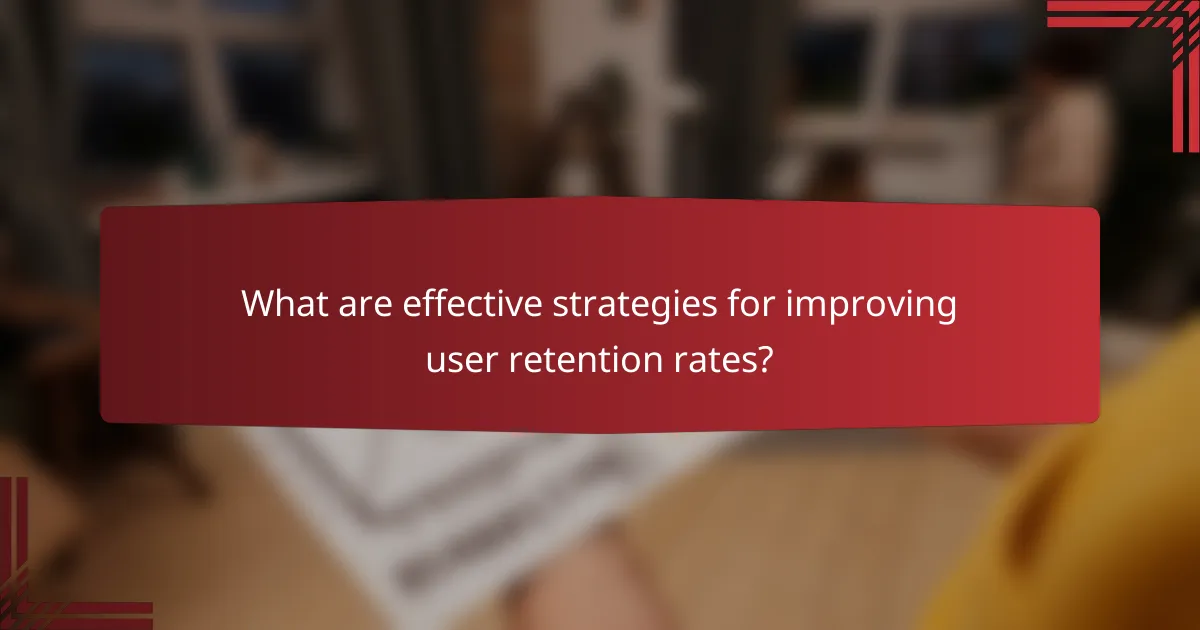User retention rates are critical for the long-term success of any business, as they reflect how well a company keeps its customers engaged over time. By employing effective strategies such as personalized experiences and loyalty rewards, businesses can significantly enhance user satisfaction. Additionally, leveraging metrics and analytics tools allows companies to track retention trends and make informed decisions to improve their customer engagement efforts.

What are effective strategies for improving user retention rates?
Effective strategies for improving user retention rates focus on creating a personalized experience, rewarding loyalty, integrating customer feedback, engaging content, and enhancing onboarding processes. Implementing these strategies can significantly boost user satisfaction and encourage long-term engagement.
Personalization techniques
Personalization techniques involve tailoring the user experience based on individual preferences and behaviors. This can include customized recommendations, targeted emails, and personalized content that resonates with users’ interests.
To implement personalization, consider using data analytics to understand user behavior and preferences. A/B testing can help refine personalized approaches, ensuring they effectively meet user needs.
Loyalty programs
Loyalty programs incentivize repeat usage by rewarding customers for their continued engagement. These programs can include points systems, discounts, or exclusive access to new products and services.
When designing a loyalty program, ensure it is easy to understand and provides tangible benefits. Regularly communicate rewards and updates to keep users engaged and motivated to participate.
Customer feedback integration
Integrating customer feedback is crucial for understanding user needs and improving retention. Regularly solicit feedback through surveys, reviews, and direct communication to gather insights on user experiences.
Act on the feedback received by making necessary adjustments to your product or service. Communicating changes based on user input can enhance trust and show users that their opinions are valued.
Content engagement initiatives
Content engagement initiatives aim to keep users interested and involved with your brand. This can include blogs, webinars, tutorials, and interactive content that encourages participation.
To maximize engagement, create a content calendar that aligns with user interests and seasonal trends. Encourage user-generated content to foster community and enhance connection with your brand.
Onboarding enhancements
Enhancing the onboarding process can significantly impact user retention by ensuring new users understand how to use your product effectively. A smooth onboarding experience helps users realize the value of your offering quickly.
Consider using guided tutorials, interactive walkthroughs, and helpful resources during onboarding. Regularly review and update onboarding materials based on user feedback to ensure they remain effective and relevant.

How can metrics be used to measure user retention?
Metrics are essential for measuring user retention as they provide quantifiable data on how well a business keeps its customers over time. By analyzing these metrics, companies can identify trends, understand user behavior, and implement strategies to improve retention rates.
Churn rate analysis
Churn rate analysis focuses on the percentage of customers who stop using a service during a specific period. A high churn rate indicates potential issues with customer satisfaction or product value. Businesses should aim to keep churn rates low, ideally in the single digits, by regularly assessing customer feedback and addressing pain points.
To calculate churn rate, divide the number of customers lost during a period by the total number of customers at the start of that period. For example, if a company starts with 1,000 customers and loses 50, the churn rate would be 5%. Regular monitoring can help identify patterns and inform retention strategies.
Customer lifetime value (CLV)
Customer lifetime value (CLV) estimates the total revenue a business can expect from a single customer throughout their relationship. Understanding CLV helps businesses determine how much they can invest in acquiring and retaining customers. A higher CLV indicates that customers are more likely to stay engaged and make repeat purchases.
To calculate CLV, multiply the average purchase value by the average purchase frequency and the average customer lifespan. For instance, if a customer spends $100 per purchase, buys twice a year, and stays for five years, the CLV would be $1,000. This metric can guide marketing budgets and retention efforts.
Net promoter score (NPS)
Net promoter score (NPS) measures customer loyalty by asking how likely customers are to recommend a business to others on a scale from 0 to 10. A high NPS indicates strong customer satisfaction and retention potential. Businesses should aim for an NPS above 50, which is considered excellent.
To calculate NPS, categorize respondents into promoters (9-10), passives (7-8), and detractors (0-6). Subtract the percentage of detractors from the percentage of promoters. Regularly surveying customers can provide insights into their experiences and help identify areas for improvement.
Repeat purchase rate
The repeat purchase rate measures the percentage of customers who make more than one purchase within a given timeframe. A higher repeat purchase rate signifies strong customer loyalty and satisfaction. Businesses should aim for a repeat purchase rate of at least 20-30% to ensure ongoing engagement.
To calculate the repeat purchase rate, divide the number of customers who made multiple purchases by the total number of customers during the same period. For example, if 200 out of 1,000 customers made repeat purchases, the rate would be 20%. Encouraging loyalty programs and personalized marketing can help increase this metric.
![]()
What are the best practices for tracking user retention?
To effectively track user retention, it is essential to implement a combination of analytics tools, data segmentation, and regular reporting. These practices help businesses understand user behavior and identify areas for improvement, ultimately enhancing retention rates.
Utilizing analytics tools like Google Analytics
Analytics tools such as Google Analytics provide valuable insights into user behavior and retention metrics. By setting up specific goals and tracking user interactions, businesses can monitor how often users return to their platform. Utilizing features like cohort analysis can help identify trends in user retention over time.
To maximize the effectiveness of these tools, ensure that event tracking is properly configured. This allows for a more granular view of user engagement, enabling you to pinpoint which features or content keep users coming back.
Segmenting user data
Segmenting user data is crucial for understanding different user groups and their retention patterns. By categorizing users based on demographics, behavior, or acquisition channels, businesses can tailor their retention strategies to meet the specific needs of each segment. For instance, new users may require different engagement tactics compared to long-term users.
Consider using segmentation to analyze retention rates across various cohorts, such as users who signed up during a promotional campaign versus those who joined organically. This can reveal which strategies are most effective in retaining different types of users.
Regular reporting and review
Establishing a routine for reporting and reviewing retention metrics is vital for ongoing improvement. Schedule regular check-ins, such as monthly or quarterly reviews, to assess user retention data and identify trends. This practice helps ensure that retention strategies remain aligned with user needs and market changes.
During these reviews, focus on key performance indicators (KPIs) such as churn rate, repeat visit frequency, and customer lifetime value. By consistently analyzing these metrics, businesses can adapt their strategies and implement timely interventions to boost user retention.

What are common challenges in maintaining user retention?
Maintaining user retention can be difficult due to various factors that impact user experience and satisfaction. Key challenges include market competition, changing user preferences, and technical issues that can disrupt service delivery.
Market competition
In a crowded marketplace, businesses face the constant challenge of differentiating themselves from competitors. Users have numerous options, making it crucial to offer unique value propositions and superior experiences. Regularly analyzing competitors’ offerings can help identify gaps and opportunities for improvement.
To stay ahead, companies should focus on building brand loyalty through personalized marketing and customer engagement strategies. Offering loyalty programs or exclusive content can also enhance user retention in a competitive environment.
Changing user preferences
User preferences can shift rapidly due to trends, technological advancements, or cultural changes. Staying attuned to these shifts is essential for maintaining relevance and user interest. Conducting regular surveys or utilizing analytics tools can help track these changes effectively.
Adapting to user feedback and being flexible in product offerings can significantly enhance retention rates. For instance, if users express interest in new features or services, prioritizing their development can lead to increased satisfaction and loyalty.
Technical issues
Technical problems, such as website downtime or app crashes, can severely impact user retention. Users expect seamless experiences, and any disruption can lead to frustration and abandonment. Regular maintenance and robust testing protocols are essential to minimize these issues.
Implementing a reliable customer support system can also help address technical concerns promptly, thereby improving user trust and retention. Additionally, investing in scalable infrastructure can prepare businesses for increased user demand without compromising performance.


